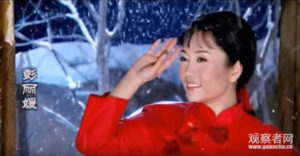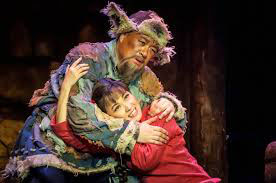On a dark and stormy night in pre-Liberation times, landlords from a town in Shaanxi gather in the mountains to pray to their ancestors. A sudden thunderclap, and a flash of lightning suddenly illuminates the visage of a woman with translucently white hair, her clothes reduced to rags. Mistaking her for a vengeful spirit, the men run screaming from the temple, never to return.
So goes the revolutionary opera The White Haired Girl 白毛女, first performed in 1945 in Yan’an. Its climactic revenge scene is meant to represent the symbolic triumph of the peasantry against the landed gentry and to foreshadow the eventual triumph of communism over feudalism.
The story is based on Chinese folktales that themselves were inspired by true events. They told of ghostly women with pure white hair despite their youth, thanks to malnutrition and lack of salt (and iodine), who roamed the mountains after fleeing a despotic landlord. The writer Li Mantian 李满天 wrote a short story based on these folktales in 1944 and presented it to the Communist cultural official Zhou Yang 周扬, who would later become the chairman of the China Federation of Literary and Art Circles. The story went through several edits, transforming from a simple ghost story into a politically symbolic tale of liberation. The opera based on the story combines vocal styles from Western opera with stylised movements inspired by Peking opera, a theatrical embodiment of the Party’s efforts to engineer a modern aesthetic wedded to ideological principles.
The narrative centres on Xi’er 喜儿, the daughter of a poor farmer in Shaanxi province. When her father is unable to pay back the debts he owes to Huang Shiren 黄世仁, the local landlord, Huang seizes Xi’er, who is betrothed to another poor farmer, Wang Dachun 王大春, to be his concubine. She escapes and flees into the mountains, where she survives for years before being found again by her fiancé, who had joined the Communists’ Eighth Route Army and fought in the Anti-Japanese War. They rejoice.
Mao was reportedly moved to tears the first time he saw the opera. In 1950, it was turned into a movie of the same name, becoming one of the classics of revolutionary Chinese film and named one of the ‘eight model revolutionary operas’ during the Cultural Revolution. Later, The White Haired Girl was adapted for Peking opera (1958) and the ballet (1965).
Fast forward to the twenty-first century. In October 2014, Xi Jinping delivered a speech on the role of literature and arts in China that was a conscious echo of Mao’s original ‘Talks at the Yan’an Forum on Art and Literature’. In it, Xi stressed that art and culture was to serve the people: ‘Art and culture will emit the greatest positive energy when the Marxist view of art and culture is firmly established and the people are their focus’. He criticised the ‘cultural garbage’ that results when artists fail to live up to such standards and ‘indulge in kitsch’. In other words, artists and the arts must obey and support Communist rule.
Shortly after Xi’s speech, China’s Ministry of Culture announced a revival tour of The White Haired Girl, which opened in Yan’an in November 2015 and finished in Beijing in mid-December. It underwent a makeover to appeal to modern audiences, including 3D visual effects. Xi’s wife, the singer Peng Liyuan served as the production’s artistic director; in the 1980s she herself played Xi’er, a highly coveted role, when she was a star performer with the People’s Liberation Army song-and-dance troupe.
A pared-down orchestral version of The White Haired Girl also enjoyed a one-off performance in March 2016 at The National Centre for Performing Arts in Beijing. After previous performances, Chinese news reports described audience members young and old raving about the undiminished emotional power of the opera, even seventy years later. But here, even among the fifty and sixty year olds in the audience, who had seen the original production in their youth, audience members chuckled during otherwise serious moments at some of the more outlandish and clichéd elements of the plot and presentation, including the extremely tattered clothing of the peasants. As the music swelled, people checked their phones. Yet in the final scene, when Xi’er and Wang Dachun embraced after years of separation, any remaining cynicism gave way to a collective moment of silence as woman, soldier, and peasants linked arms and waved, the picture of a happy family.




